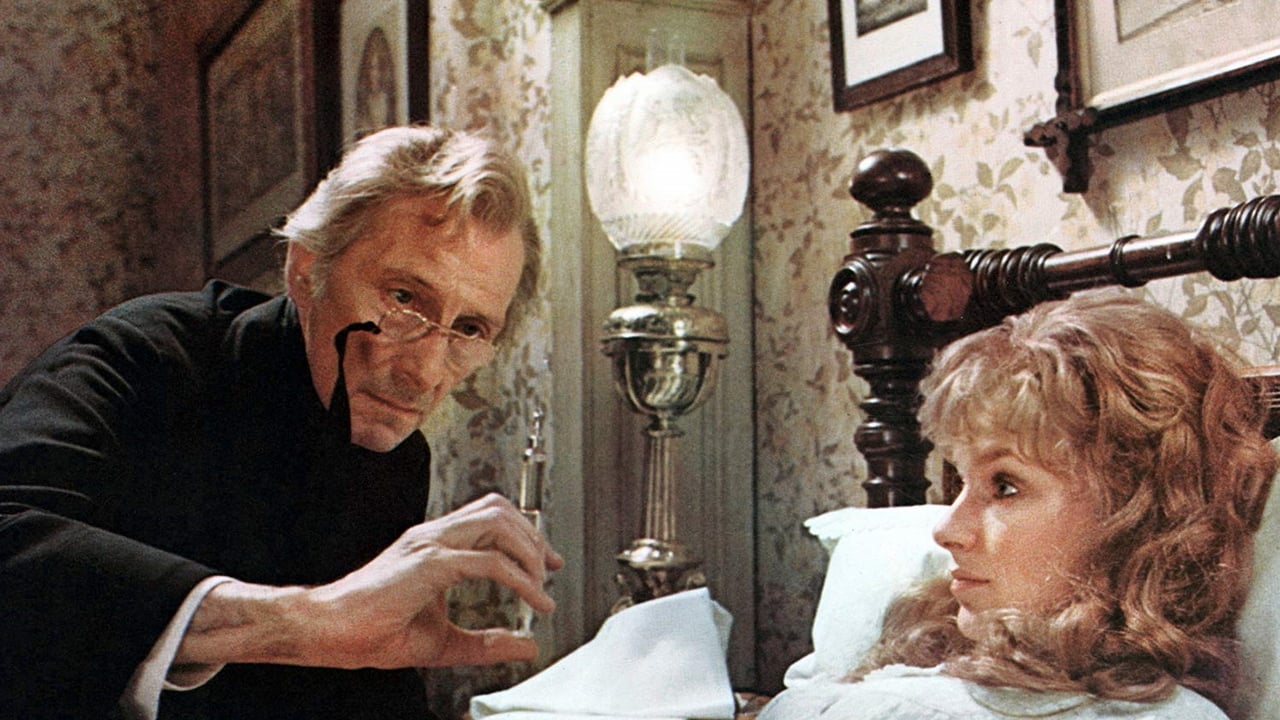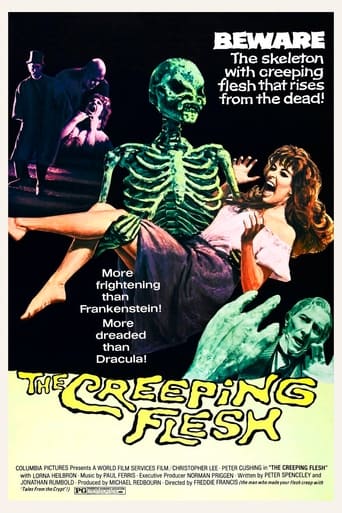Interesteg
What makes it different from others?
Brightlyme
i know i wasted 90 mins of my life.
CrawlerChunky
In truth, there is barely enough story here to make a film.
ActuallyGlimmer
The best films of this genre always show a path and provide a takeaway for being a better person.
Nigel P
Tigon films never made a secret of being inspired by the larger Hammer horror company: this film is perhaps most indebted to their rival. It stars Peter Cushing, Christopher Lee and briefly Michael Ripper, and the story's Victorian setting is familiar to Hammer fans. I don't know how successful this was upon release. It was actually Tigon's final horror outing, the company having all but ceased by the time of the film's release, having been rebranded as the very different The Laurie Marsh Group. I have a feeling it would have been more lucrative had it been released ten years earlier, when such a style of story-telling was in its prime.Cushing plays Professor Emmanuel Hildern, first seen (minus toupee) alongside elegant actor David Bailie in an almost psychedelic, featureless laboratory set relaying the story we are about to see. Lee is typically and masterfully cold and officious as brother James, whose ambition far outweighs any loyalty to his sibling. The charming Lorna Hailbron is Emmanuel's daughter Penelope, stoically attempting to keep the family home alive despite debilitating finances brought about by her father's experimentation into the dawn of creation. Emmanuel is fiercely over-protective of his daughter following his wife's descent into madness; he fears the condition may be hereditary. As it is, his deception is the instigator of Penelope's rapid decline. Too rapid, in my view – for years she has been the most sensible family member; suddenly she is certifiable.Such experiments regurgitate the skeleton of a previously unknown, outsized monolithic humanoid creature. The interesting thing is, unlikely as it may seem, any contact with water puts flesh back on the bones and brings the old boy to life! Energised by this revelation, Emmanuel removes one of the creature's fingers in order to investigate further (some suggest a certain phallic similarity with the outsized digit, which in the hands of lesser an actor than Cushing, could result in chortles from the audience during his examination of the prop). We are treated to many close-ups of the dormant monster, as if he is observing throughout.This is lovingly, sedately directed by Freddie Francis and seems to be well budgeted. James' asylum setting is impressive, as is the lively plight of escaped inmate Lennie (Kenneth J Warren), although this entertaining side-step has little to do with the plot.A word for Cushing's performance. It's a given really, that he always puts in a fine performance, but this fragile, broken soul is amongst his best. The ending, and the lead-up to it, is true classic horror with the creature finally animated and seen in restrained long-shots. Cushing sobbing and defeated after the creature has come to claim its revenge, is heart-breaking.
Jonathon Dabell
Freddie Francis finds himself working for Tigon on the ambitious, albeit flawed, horror opus The Creeping Flesh. It's always fun to see Cushing and Lee working together and this is no exception, although it's fair to say that they don't get enough shared screen time in this particular film. Nevertheless, The Creeping Flesh is an extremely interesting and well-made offering. Ultimately it bites off more than it can chew, but there's still plenty of enjoyment to be had from a viewing of it.Victorian scientist Emmanuel Hildern (Cushing) returns from New Guinea with the skeletal remains of a humanoid creature. His excitement about the creature is tempered somewhat when he discovers his wife has died while he has been away. Not that their relationship was a normal one anyway – Mrs Hildern had been put into a lunatic asylum run by Emmanuel's brother, James (Christopher Lee), on account of her unquenchable sexual appetite. Furthermore, Emmanuel's daughter, Penelope (Lorna Heilbron), has no idea that her mother has been locked away, believing that she died years ago. Whilst examining the skeleton, Emmanuel discovers if it comes into contact with water its flesh and blood cells are able to regenerate. In other words, the skeleton can regrow flesh when wet. Believing the creature may be the 'Evil One' mentioned in the ancient prophecies of the tribes of New Guinea, Emmanuel decides to investigate further. He discovers strange cells in the creature's biological make-up and concludes they may be a germ-like form of evil, suggesting that evil itself is a virus like any other, as easy to 'catch' as a common cold. Emmanuel attempts to use the cells to create a vaccine against evil. He tests it on his daughter, believing that she may need to be protected in order to prevent her from turning out like her mother. Alas, his tests have the opposite effect and soon Penelope becomes a dangerous murderess intent on luring others to their death. Meanwhile, James plots to steal the New Guinean skeleton for himself… but makes the mistake of attempting to spirit it away during a rainstorm.As one can see, there's an awful lot going on in The Creeping Flesh considering that it is merely a 94 minute horror film. We have brotherly rivalry and betrayal; messed-up family politics; tribal prophecies; a flesh-growing monster; and the radical concept of evil as a contagious illness rather than an immoral mind-set. Where The Creeping Flesh comes undone somewhat is in its doomed effort to tie so many disparate components together into a coherent whole.Fortunately, the good points outweigh the flaws, resulting in a film that is worth watching in spite of any weaknesses. Flawed it may well be, but The Creeping Flesh still has much to admire. It takes a while to click into gear, biding its time in setting up the main 'evil-on-the-loose' story thread. However, once the consequences of Emmanuel's experimentations become clear - with Penelope going on a murderous rampage - things become exciting and compelling. Plus, of course, running alongside this thread we have the scheme hatched by Lee's character to steal the creature, not realising the potentially catastrophic result of taking it outside in the rain. With its steady but intriguing build-up, disturbing apocalyptic ending and plenty of atmospheric chills in between, The Creeping Flesh is a film that undeniably rewards patient viewing.
Witchfinder General 666
Horror deities Peter Cushing and Christopher Lee are arguable the best acting-team that Horror cinema has ever known, their collaborations including Hammer Horror Classics such as "The Curse of Frankenstein" (1957), "Dracula" (1958), or "The Gorgon" (1964), as well as many other fantastic Horror films including "Horror Express" (1970). A production from the British Tigon company, "The Creeping Flesh" of 1973 is yet another great Gothic example for what a prefect duo of the uncanny the two Horror icons and real-life friends formed. After the Michael Reeves' masterpiece "Witchfinder General" (1968) starring the fellow Horror-deity Vincent Price, and Piers Haggard's "Blood on Satan's Claw" (1971), "The Creeping Flesh" is probably Tigon's third-best production.The ambitious but good-natured scientist Emannuel Hildern (Peter Cushing) discovers the skeleton of a supposed primate in New Guinea. Upon his return to England, however, suspicions arise that the skeleton may be infested with evil. In the meanwhile, Hildern's malevolent and cruel brother James (Christopher Lee), who leads an insane asylum, is keen on taking his brother's discovery away from him... Cushing and Lee are fantastic as always. Lorna Heilbron is also very good in the role of Cushing's innocent and beautiful daughter. The film's plot has been compared to that of Eugenio Martin's Cushing/Lee collaboration "Horror Express", and while I still prefer "Horror Express" over this one, I must say that "The Creeping Flesh" follows several additional ideas. The atmosphere is constantly creepy and the Victorian English settings and Gothic buildings make the prefect setting for a film of the kind (even though there have been greater locations in British Horror films, including most of Hammer's productions). Overall, "The Creeping Flesh" is an exquisitely entertaining and very creepy addition to the filmography of Peter Cushing and Christopher Lee, and no lover of British Gothic Horror should miss it. Highly recommended!
Prof-Hieronymos-Grost
Scientist and widower, Emmanuel Hildern returns t Victorian England, from a long expedition to Papua New Guinea, where he has found the skeletal remains of what he believes to be a "Missing link" that will dispel Darwins's theory of evolution and perhaps prove his theory that pure evil is a disease that can be cured. Emmanuel receives a letter form his half brother, James, who runs the local sanitarium, its states that his mentally deranged wife had passed away there, his daughter Penelope believes her mother was dead a long time but Emmanuel has been hiding the truth to protect her, his ever growing fears are that the madness of her mother might me hereditary. His experiments on his skeleton sees him accidentally stumble on a way to reanimate the creature by adding water, he takes some blood cells from the creature, a mythical force of evil, and proceeds to find a cure for evil, he injects his daughter with it to protect her from madness, he however finds out his conclusions were a little premature with devastating results for him and Penelope. What can I say, I'm a sucker for Victorian era horror, if it has Cushing and Lee all the better, this one does. Tigon's The Creeping Flesh follows some faux science, but then that era had many such implausible idealists so I always forgive such misgivings. If the film has a fault, its that is follows too many of these ideas and ideals and that the rather unique creature only turns up very late on, still though its one of Francis's better pictures, Cushing is as always in his element as the befuddled mad scientist who fails to see the errors of his ways, Lee is cool too, as the obnoxious and calculating James Hildern who has his sights set on stealing the Richter Prize away from his brother by any means possible, there's also a nice twist that will have you guessing whether or not all you have seen actually happened at all.

